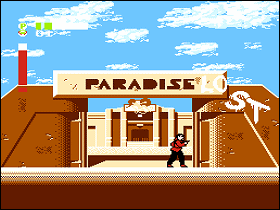 The Game: Sybok, a charismatic Vulcan cult leader, has tried to disrupt the peace process on the neutral planet Nimbus III. Players take control of one Enterprise crewman at a time to: retrieve the Nimbus III hostages (Sulu), save Kirk and Spock from a cell aboard the Enterprise (Scotty), pilot the Enterprise through asteroids and attacking Klingons (Sulu again?), and finally make a mad dash into the heart of the lair of the “god creature” (Kirk). Running out of life energy aborts the mission; fortunately, Dr. McCoy is standing by at all times and the mission can start from scratch. (Bandai, 1989 – unreleased)
The Game: Sybok, a charismatic Vulcan cult leader, has tried to disrupt the peace process on the neutral planet Nimbus III. Players take control of one Enterprise crewman at a time to: retrieve the Nimbus III hostages (Sulu), save Kirk and Spock from a cell aboard the Enterprise (Scotty), pilot the Enterprise through asteroids and attacking Klingons (Sulu again?), and finally make a mad dash into the heart of the lair of the “god creature” (Kirk). Running out of life energy aborts the mission; fortunately, Dr. McCoy is standing by at all times and the mission can start from scratch. (Bandai, 1989 – unreleased)
Memories: After the surprise hit that was the movie Star Trek IV: The Voyage Home, Paramount Pictures was ready to entertain any and all licensing ideas for the next movie, 1989’s Star Trek V: The Final Frontier (which was therefore perversely considered the worst of the original series movies). Bandai bid for the video game rights, and then proceeded to create a rather uninspired run-and-shoot platformer around what would appear to be an early synopsis of the movie’s plot. (To be fair to Bandai, the movie wasn’t exactly the most inspiring entry in the Star Trek captain’s log, so the fault doesn’t lie entirely with the developer.)
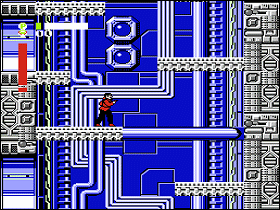 The first stage involves Sulu running and gunning his way through Sybok’s followers to reach and free hostages in Nimbus III’s Paradise City (how is it that, even though we only ever hear the Enterprise crew listening to jazz or classical, there’s a placename providing clear evidence that Guns N Roses survived to the 23rd century?) The key to surviving this level lies in jumping over and then shooting opponents in the back. Oh my.
The first stage involves Sulu running and gunning his way through Sybok’s followers to reach and free hostages in Nimbus III’s Paradise City (how is it that, even though we only ever hear the Enterprise crew listening to jazz or classical, there’s a placename providing clear evidence that Guns N Roses survived to the 23rd century?) The key to surviving this level lies in jumping over and then shooting opponents in the back. Oh my.
The next stage is a run, gun, and jump-to-different-levels exercise, with the player taking on the role of Scotty – or, as the obviously unfinished game says in on-screen text, “Scotto” – to free Kirk, Spock and McCoy from the Enterprise’s own containment cells. 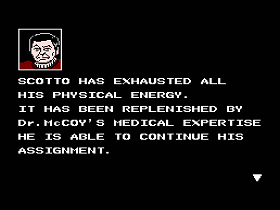 Sybok’s followers, a dime a dozen on Nimbus III, once again crowd the corridors of the Enterprise (one can only assume that a recruiting drive was held after Sulu’s shoot-’em-in-the-back killing spree on the planet), along with automatic defense mechanisms that have to be taken out. Scotty does indeed bust Kirk and friends out of jail in the movie, but the things he does in this game are just… unlikely. Trek fans the world over, myself included, loved James Doohan, but the man was hardly an action hero.
Sybok’s followers, a dime a dozen on Nimbus III, once again crowd the corridors of the Enterprise (one can only assume that a recruiting drive was held after Sulu’s shoot-’em-in-the-back killing spree on the planet), along with automatic defense mechanisms that have to be taken out. Scotty does indeed bust Kirk and friends out of jail in the movie, but the things he does in this game are just… unlikely. Trek fans the world over, myself included, loved James Doohan, but the man was hardly an action hero.
The third stage is a rudimentary cockpit space shooter that offers little in the way of innovation or improvement over, say, Star Voyager on the Atari 2600. The Enterprise takes so many asteroid hits that Scotto, sorry, Scotty surely has his hands full and has to stop leaping around in the turbolift shaft.
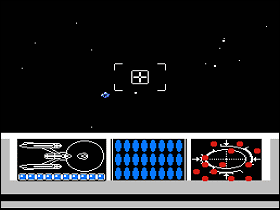 The final stage puts players in the shoes that they would’ve been paying their money to inhabit all along: Captain Kirk himself. In a scene that’s a bit disconnected from the finished movie, Kirk dodges rolling and falling boulders in a level filched shamelessly from classic arcade games like Jungle Hunt, which eventually leads to a bit of platform-jumping and a confrontation with… an empty space that the game’s designers never got around to filling. Assuming that the game was developed around an early draft of the script (highly likely, if the game was intended to be released in tandem with the movie’s theatrical run), the intention may have been to have a boss battle with a giant rock monster (a sequence dropped from the movie due to budget concerns).
The final stage puts players in the shoes that they would’ve been paying their money to inhabit all along: Captain Kirk himself. In a scene that’s a bit disconnected from the finished movie, Kirk dodges rolling and falling boulders in a level filched shamelessly from classic arcade games like Jungle Hunt, which eventually leads to a bit of platform-jumping and a confrontation with… an empty space that the game’s designers never got around to filling. Assuming that the game was developed around an early draft of the script (highly likely, if the game was intended to be released in tandem with the movie’s theatrical run), the intention may have been to have a boss battle with a giant rock monster (a sequence dropped from the movie due to budget concerns).
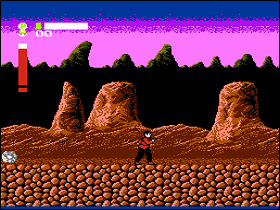 If there’s an impression that’s easy to glean from the Star Trek V game, it’s the impression of a quickly-whipped-out movie tie-in game, a category that was far too large in the NES library to begin with. The game has nothing to distinguish it, and – at the risk of starting a geek elitist argument – there’s nothing to really make it worthy of the Star Trek name.
If there’s an impression that’s easy to glean from the Star Trek V game, it’s the impression of a quickly-whipped-out movie tie-in game, a category that was far too large in the NES library to begin with. The game has nothing to distinguish it, and – at the risk of starting a geek elitist argument – there’s nothing to really make it worthy of the Star Trek name.
Fortunately, Star Trek on the NES would wait a few more years – Star Trek 25th Anniversary, though not perfect, was a significant improvement in the “beam down and explore” style of game 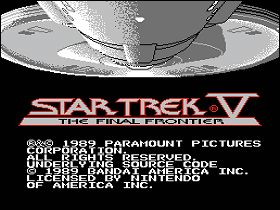 play, while the Star Trek: The Next Generation game, issued mere months before that series left the airwaves, offered a better “fly the ship
play, while the Star Trek: The Next Generation game, issued mere months before that series left the airwaves, offered a better “fly the ship  and shoot at stuff” experience. Releasing Star Trek V would have risked tarring future games in the Trek franchise with the same mediocre brush. This game was best left in the neutral zone.
and shoot at stuff” experience. Releasing Star Trek V would have risked tarring future games in the Trek franchise with the same mediocre brush. This game was best left in the neutral zone.